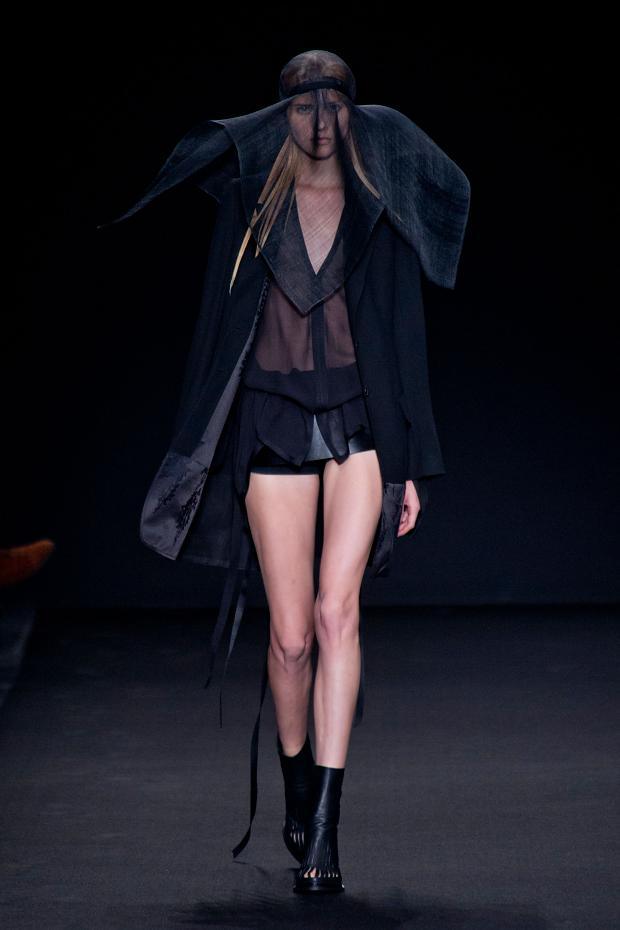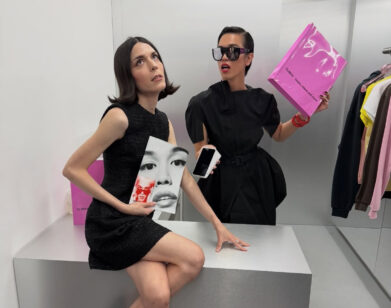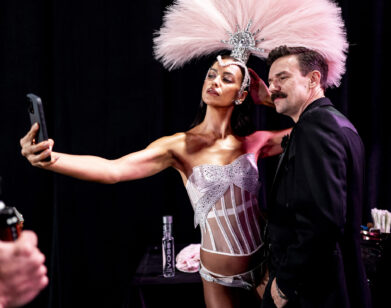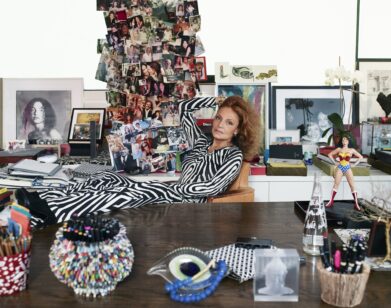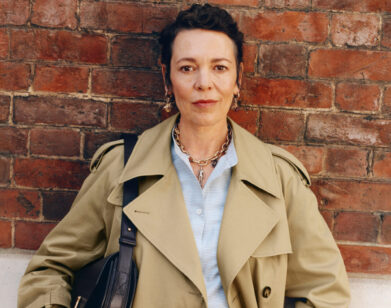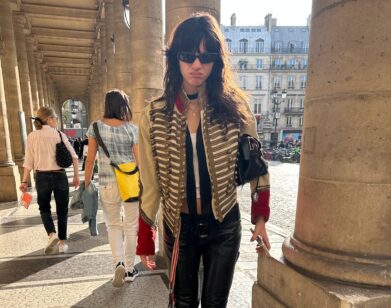In Paris, the Theater Returns
After an age of minimalism gracing the Paris catwalks and filtering down through the fashion system, it seems that designers are ready to bounce back to their own, inverted aesthetic worlds. This sentiment clicked at Jun Takahashi’s Undercover show, with the spoken word introduction by British postpunk band Savages declaring “Perhaps having deconstructed everything, we should think about putting everything back together.” Their poignant message of digital overstimulation was imbued throughout the Japanese designer’s electrified collection, which featured marinière stripes, tweed jackets, and even football jerseys reworked with irreverent details like satin bows, safety pins, PVC, and chain-link appliqué. A giant hip-hop belt buckle spelled GOD in the front and DOG in the back, in one of the most pointed expressions of the dystopian future Takahashi hopes to quell with his pro-analog protest.
Canadian designer Nicolas Andreas Taralis seconded that message, inviting guests into a dark theater to witness his collection in a short film by Japanese director Mote Sinabel Aoki. Taralis creates a melancholy, intellectual sort of fashion with a darkly glamorous edge, and this cinematic outing had a detached, distant aura—something the designer related to the “dematerialization” of our daily lives and personal interactions. Garment-wise, he pushed an interchangeable wardrobe for men and women, re-imagining patchwork shirting (he had artist Gordon Matta Clark on his mind) and splitting jackets only to sew and glue them back together. An asymmetric punched cotton blazer and leather-trimmed bolero bustier were the season’s freshest propositions, and the flecks of metallic topstitch throughout have become a desirable trademark.
At Ann Demeulemeester‘s usual venue (a 16th century vaulted convent), the Antwerp designer’s willowy tribeswomen wore wimple-like headwear—delicate hessian sunhats that warped around the models’ faces with translucent veils—yet there was nothing clerical about her seductive Spring wardrobe. Flocked velvet may seem an unlikely summer staple, however Ann (ever the pioneering spirit) applied it over nude-coloured tulle and cut it into breezy, bustled gowns, swinging shiftdresses, and silky tattoo hosiery. The pattern story was elaborate; being the fruit of a continuing dialogue with her son Viktor (a graphic designer), and echoed the Jugendstil flourishes of the Art Nouveau and Beetlejuice stripes, as well as the wisteria motif that appeared in her June men’s wear show. It was a welcome return to texture after several seasons of shadowy minimalism and, when rendered in rich vermillion and peach tones, was nothing short of exultant.
With his swansong collection at Rochas (he’s off to head Schiaparelli), designer Marco Zanini celebrated the 1944 Tennessee Williams play The Glass Menagerie, a post-war romance whose gentle heroine occupies her time with a collection of glass animal figurines. Transposing that crystalline inspiration onto wafting a-line coats and tiered dresses, Zanini added a futuristic touch to traditional fabrications for a shining, effervescent effect. Glazed devoré velvet came in icy pastel shades like pale chartreuse and baby blue, with shaggy marabou slippers grazing the floor of the Theatre Chaillot. Add to the mix filmy cardigans, interminable ruffles, and pleated lamé, and Zanini’s saccharine sweet collection spun his carnival of geek-chic to another level.
The balance of sweet and sour was skewed towards the latter at Raf Simons’ third ready-to-wear show for Christian Dior today, when he commissioned a tropical greenhouse in the grounds of the Musee Rodin and had it filled with a noxious mix of fresh and artificial hanging flowers. Thinking, once again, of Monsieur Dior’s idea of “flower women,” Simons pushed the bar (and the Bar jacket) a little further on his own, intellectual tangent—playing a hide-and-seek game of intricate, lustrous details applied onto artfully sliced cocktail wear. Dividing the show into the somewhat vague themes of “Traveller,” “Transformer,” and “Transporter,” the show notes explained the sophisticated and global “tribe” of Dior women and the mix of hybrid garments in which they dress—say, high-waisted shorts trimmed in silk pleats or a gathered shirt dress, opened at the back and crossed with a beaded bracelet collar. Each look was imbued with the unsettling, poisonous palette of the set, from the arching beaded collars down to the strapped cage sandals boldly branded “Christian Dior été 2014.” A final passage signaled a somewhat premature “best of” for the designer, with an edit of his past looks for the house re-cut in silver jacquard: each emblazoned with an crystal houndstooth Dior badge. It was that racy sportif touch that turned this show around, proving Simons still has much to say in his slow and studied evolution at the house.

